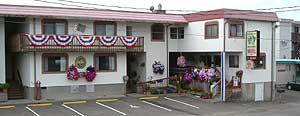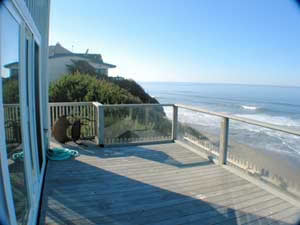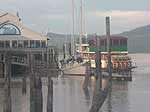 |
New Claims, Problems for Oregon Coast Artifacts and Oddities |
|---|
Covering 180 miles of Oregon coast travel: Astoria, Seaside, Cannon Beach, Manzanita, Nehalem, Wheeler, Rockaway, Garibaldi, Tillamook, Oceanside, Pacific City, Lincoln City, Depoe Bay, Newport, Waldport, Yachats & Florence.
03/05/08
Secrets of the Season |
New Claims, Problems for Oregon Coast Artifacts and Oddities
 |
| One of the cannon found near Cannon Beach recently (photo Tiffany Boothe, Seaside Aquarium) |
(Manzanita, Oregon) - Artifacts recently found on the coast apparently have a new owner and some exceptionally strange tourist attractions may be in danger.
Those famed and possibly historically significant cannon found last month on the north Oregon coast are, it turns out, owned by the U.S. Navy.
When a family of tourists found the pair of giant guns laying the sand of Arch Cape, evidence immediately pointed to the good possibility they were from the same ship that crashed in 1846, and from which the first found cannon got the nearby community of Cannon Beach its name.
Right off the bat, various state agencies had to decide who actually owned the pair of cannon. It was soon decided that the Department of State Lands had ownership because of where they lay in the sand. Although recently the U.S. Navy sent all parties involved a friendly reminder that it actually owned the pieces of the ship, even after more than a century.
|
Tradewinds Motel, Rockaway Beach. All rooms are immaculate and have TV’s, VCR’s and in-room phones w/ data ports. Oceanfronts have queen bed, a double hide-a-bed, kitchen, cozy firelog fireplace and private deck. Both types sleep up to four people. Others are appointed for a two-person romantic getaway, yet still perfect for those on a budget. Elaborate oceanfront Jacuzzi suite has two bedrooms, kitchen, double hide-a-bed, fireplace and private deck, sleeping as many as six. For family reunions or large gatherings such as weddings, some rooms can connect to create two-room and three-room suites. Some rooms pet friendly. 523 N. Pacific St., Rockaway Beach. (503) 355-2112 - 1-800-824-0938. www.tradewinds-motel.com |
 |
| One of the cannon in the preservation tanks at Nehalem Bay State Park |
The cannon could well be from the USS Shark, an 86-foot-long schooner that wrecked at the mouth of the Columbia River. The first cannon from the ship was found in 1898.
This reminder from the feds changes little to nothing on the approach of State Lands, Oregon State Parks and Recreation and the other local historians involved in the restoration of or decision as to the fate of the cannon. It simply means the Navy has ultimate say. The goals of all are the same: to preserve them, eventually restore them, discover their origin and then put them on display for the public.
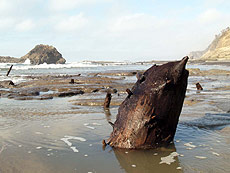 |
| Part of the ghost forest at Arch Cape (photo Boothe) |
Robert Neyland, from the Navy's Underwater Archaeological Branch at the Naval Historical Center in Washington, D.C., has publicly said the cannon should be in the public eye.
These types of guns – called a caronnade - are rare. Neyland’s office has said that not much is known about this period of naval war history, so this is an exciting development for the Navy as well.
The cannon are currently housed in Nehalem Bay State Park in Manzanita, undergoing preservation efforts.
|
Arch
Cape Property Services.
Dozens of homes in that dreamy,
rugged stretch between Cannon Beach and Manzanita known as Arch
Cape. Oceanfront and ocean view , or just a short walk from the
sea. |
So far, there is no record that the Navy tried to retrieve the first cannon that was proven to be from the Shark.
In the meantime, the low sand levels that resulted in these historic finds, as well as a bold display of ghost forests and other geologic oddities, has made for an uncomfortable future for one of the famed ghost forests.
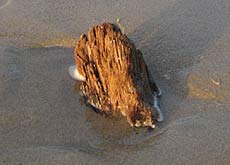 |
| Ghost forest stump near Cape Kiwanda |
Ghost forests are the almost petrified remnants of various stands of trees that are 1,000 to 4,000 years old, which have popped out of the sand in some spots along the coast, mostly in the form of stumps. They’ve been spotted near Yachats, near Seal Rock, north of Newport, Cape Kiwanda State Park (sometimes known as McPhillips Beach), at Cape Lookout State Park, Rockaway, Arch Cape and Hug Point State Park.
In Neskowin, however, where they’re larger than usual, the low sand levels are also much lower than many places, and seem to be receding at an alarming rate. Consequently, this eerie stand of stumps and twisted figures is visible year-round, enabling tourists to catch a very unusual glimpse of the coast’s past.
 |
| Ghost forest at Neskowin: it may be in danger |
They may be in danger, however. Beach ranger David Woody, with Oregon State Parks and Recreation Department, said the stumps at Neskowin – about 1,000 to 2,000 years old – are showing so much they’re starting to get uprooted.
“I found some a ways up the road, at the beach at Winema,” Woody said.
One authoritative geologist agreed.
"Waves have torn up Sitka spruce trees that were rooted in place for one to two thousand years at Neskowin, south of Proposal Rock, and at Cape Lookout State Park, along with great chunks of forest soil,” said Roger Hart, a geologist with Oregon Department of Gem and Mineral Industries. “They’ve strewn them all over beaches between Cascade Head and Cape Meares.”
These ancient stumps around the coast were first killed and then preserved by encroaching sand, clay or some type of muck, which usually took a period of decades or so. This happened thousands of years ago.
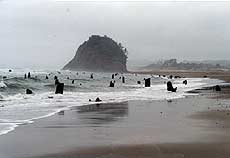 Another
dynamic has appeared which worries officials about these rarities. Normally,
the ghost forest tree limbs and stumps at Neskowin collect barnacles and
other sea life clinging to it during times when the tide surrounds it.
Another
dynamic has appeared which worries officials about these rarities. Normally,
the ghost forest tree limbs and stumps at Neskowin collect barnacles and
other sea life clinging to it during times when the tide surrounds it.
But some of them are missing that evidence of marine goo below a certain level. It’s the same dynamic as many rocks at tide pools which suddenly show areas without sea life, because sand levels have shrunk to expose an area that was normally off limits to these creatures.
Even these specimens at Neskowin – which are ironically the result of sand levels sinking low enough to expose them in the first place - are getting exposed so much they’re showing bare bark.
It all spells the possibility sand levels on the Oregon coast are getting historically, even alarmingly low.
 |
| Ghost forest stumps near Seal Rock (photo Guy DiTorrice) |
But even these specimens at Neskowin – which are ironically the result of sand levels sinking low enough to expose them in the first place - are getting exposed so much they’re showing bare bark.
“I've been working with the Neskowin Valley School on a study of the Neskowin ghost forest,” Hart said. “The study is tied to a National Science Foundation grant on the possible effects of climate change. Is the forest being destroyed now because of an increase in erosion? The ghost forest at Neskowin is especially worth visiting.”
 Other
wild oddities visible at lower tides in Arch Cape and Hug Point include
what are called “red towers,” which are giant deposits of
reddish iron that have compacted into strange, surreal shapes.
Other
wild oddities visible at lower tides in Arch Cape and Hug Point include
what are called “red towers,” which are giant deposits of
reddish iron that have compacted into strange, surreal shapes.
Coverage of these, the ghost forests, the cannon and various shipwrecks that have appeared because of low sand levels have resulted in a massive surge of publicity for the Oregon coast. One Associated Press story about all these various finds made it around the world to at least 100 news outlets.
More stories on the subject:
Quick Facts About Oregon Coast Treasures, Geologic Wonders Much of the United States is focusing on the Oregon coast at this time, with various geologic developments and historic objects popping up left and right.
 How
To Find Oregon Coast Odd Discoveries, Artifacts If
you want to play tresure hunter or geology explorer on the coast, here's
a list of places to find the good stuff
How
To Find Oregon Coast Odd Discoveries, Artifacts If
you want to play tresure hunter or geology explorer on the coast, here's
a list of places to find the good stuff
The Science Behind Oregon Coast's Recent Treasures A big rush of unusual objects, some thousands to millions of years old, have been appearing on the Oregon coast. Here's why and how.
New Claims, Problems for Oregon Coast Artifacts and Oddities Artifacts recently found on the coast apparently have a new owner and some exceptionally strange tourist attractions may be in danger
Oregon Coast Relics Gone in Three Months Without Preservation Methods The now-famous cannon would fall apart in three months without current preservation methods, and restoring these could take as long as two years, officials said.
Treasures, Shipwrecks Create Huge Publicity for Oregon Coast It may be the biggest chunk of press the Oregon coast received since Keiko the Whale or the New Carissa shipwreck, and it's helping after the economic damage done by media coverage of the December storm
 |
A1 Beach Rentals, Lincoln City. Perfect for large family vacations all the way down to a getaway lodging for two - with over 25 vacation rental homes to choose from. A breathtaking collection of craftsman or traditional beachfront homes, or oceanview houses – from one to seven bedrooms. In various areas of Lincoln City and overlooking the beach, with some in Depoe Bay. All kinds of amenities are available, like hot tubs, decks, BBQ, rock fireplaces, beamed ceilings and more. Some are new, some are historic charmers. Lincoln City, Oregon. 1-(503)-232-5984. www.a1beachrentals.com. |
 Inn
at Cannon Beach. Beautifully wooded natural setting at quiet south
end of Cannon Beach. Great during winter storms with a new book by
the fireplace – or when the sun is out for family fun and beach
strolling. Handsome beach cottage-style architecture. Lush flowering
gardens and naturalized courtyard pond. Warm, inviting guest rooms.
Continental buffet breakfast. Warm Cookies. Family and Pet Friendly.
Welcome gifts. Smoke-free. Complimentary Wireless Connectivity. Wine
and book signing events. 800-321-6304 or 503-436-9085. Hemlock At
Surfcrest, Cannon Beach, Oregon. www.atcannonbeach.com. Inn
at Cannon Beach. Beautifully wooded natural setting at quiet south
end of Cannon Beach. Great during winter storms with a new book by
the fireplace – or when the sun is out for family fun and beach
strolling. Handsome beach cottage-style architecture. Lush flowering
gardens and naturalized courtyard pond. Warm, inviting guest rooms.
Continental buffet breakfast. Warm Cookies. Family and Pet Friendly.
Welcome gifts. Smoke-free. Complimentary Wireless Connectivity. Wine
and book signing events. 800-321-6304 or 503-436-9085. Hemlock At
Surfcrest, Cannon Beach, Oregon. www.atcannonbeach.com. |
 |
|
The Ocean Lodge. There will not be another property built like this in Cannon Beach in our lifetimes. Rare, premiere ocean front location; handsome, dramatic architecture and tasteful, fun (nostalgic) beach interiors. Overlooks Haystack Rock. 100 percent smoke free. Imaginative special occasion packages. Massive wood burning lobby fireplace. Library w/ fireplace, stocked with impressive book collection. Pet and family friendly. Lavish continental buffet breakfast. In-room fireplaces, mini-kitchens. Jacuzzi tubs in select rooms. DVD players, complimentary movies. Morning paper. Warm cookies. 888-777-4047. 503-436-2241. 2864 Pacific Street. Cannon Beach, Oregon. www.theoceanlodge.com |
Weiss' Paradise Suites & Vacation Rentals - Seaside Unique Luxury Accommodations in Seaside. 1BR Suites,
1BR & 2BR Duplex Units and 3BR Houses, units for 2-8 people.
Rent entire property for 20-26. Close to beach, river and Broadway
St. |
Lincoln City Vacation Homes Something for everyone: smaller homes with a view to a large house that sleeps 15. All are either oceanfront or just a few steps away – all with a low bank access and fantastic views. Most are in the Nelscott area; one is close to the casino. You’ll find a variety of goodies: fireplaces, multiple bedrooms, dishwashers, Jacuzzis, washer/dryers, hot tubs, cable TV, VCR, barbecues; there’s a loft in one, and another sprawling home has two apartments. Pets allowed in some homes – ask first. Each comes with complete kitchens. Most have seventh night free. Prices range from winter $85 to summer $230 per night. www.getaway2thecoast.com. 541-994-8778. |
RELATED STORIES
Click here for video of Dec. storm aftermath
Oregon Coast Best of Awards for the Year And the winners are: best of Oregon coast restaurants, lodgings, science, odd events in nature and stunning moments for 2007
Watching Transformations of Oregon Coast Beaches Seasons change and so do beaches, revealing different sides and a variety of eye-popping sights
Staggeringly Cool Ideas for Oregon Coast Romance Be it the season of Valentine's or be it any time of the year, Oregon's coastline has essentially cornered the market for cuddle-inducing possibilities and gushy activities for the hand-holding set
Day or Night Mysteries and Merriment on Oregon Coast It's more than just nightlife that comes to life, but the beaches offer major opportunities
Oregon Coast Travel Site Goes Wireless Provides Lodging Reports - Oregon Coast Beach Connection now has mobile lodging and dining listings, along with weekly lodging availability reports
|
Oregon coast mileage chart & map Day trips, suggested itineraries Search for Oregon Coast Subjects, Articles Oregon Coast Complete Guides every beach access, attraction |
|||||||||||||
OR
TAKE THE VIRTUAL TOUR |
|||||||||||||
|


